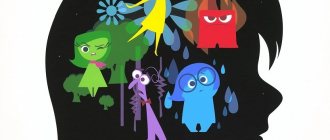Updated July 24, 2022 810 Author: Dmitry Petrov
Hello, dear readers of the KtoNaNovenkogo.ru blog. Today I want to talk about a very interesting thing - a person’s perception of the world around him and other people.
Let's take a look at this process from a psychological point of view to understand its essence. We will find out what properties it has, what types it is divided into, what errors sometimes arise and how a person perceives another person. I hope it will be interesting.
Perception - what is it?
The term "perception" can be considered in two contexts. In one of them:
Perception is the process through which images of the surrounding world are formed, a reflection of reality in the psyche.
In this case, the concept is a verb, that is, an action.
In another context, perception is a noun, an object, a result, an image itself.
Most often, science (what is this?) uses the first version of meanings. We will rely on it in this article.
Perception is synonymous with the word perception, which, in turn, translated from Latin perceptio means subjective, sensory knowledge of the environment. Words such as appreciation, acceptance, contemplation and others are also used equally.
What is perception in simple words? In the process of life, a person does not stop learning about the world. For example, in a store you are interested in some thing: you take it in your hands to understand what its texture, weight, density, color, smell, taste and so on, that is, you use the necessary senses (food - taste, book - vision).
All these characteristics cause different sensations, which together give rise to the image of the object. The process of cognition, therefore, is perception.
It is important to note that perception in psychology is not just the sum of sensations. It also includes our individual knowledge and beliefs about the world. This phenomenon is closely related to other mental processes: memory, thinking, speech, motivational sphere and attention.
Levels
In psychology, there are 4 main levels of perception:
- sensory - it is based on the senses, it is considered to be the lowest level of perception, at which all living organisms are located, however, it also depends on the level of consciousness, since a person, say, consciously, can perform certain sensory actions;
- perceptual - the object is classified at the initial stage;
- research - examination of a particular function, aspect of an object or phenomenon;
- activity - interaction with the object under study, as for the purpose of a certain activity.
Properties of perception
It is customary to distinguish 7 properties of perception:
- Selectivity is the preferential selection of one object against the background of others due to the impossibility of embracing a large number of them at the same time.
In a bookstore, you will sort through books one by one to decide which one is worth buying for further reading. When you have a specific one in your hands, at that moment all attention is focused on it: the reader examines it externally, reads the title, content, and skims through it. The rest seem to not exist, fade into the background. But as soon as interest in this publication disappears, attention moves to the next one. What was in the hands fades into the background. - Objectivity of perception – represents the assignment of an object to a certain category of environmental objects. For example, green, round, hard and sweet is an apple, a fruit, and green, long and growls is a crocodile, an animal.
Often the recognition process does not occur immediately: a person is forced to spend some time and additional effort to determine the type of object being studied (come closer, listen or smell).Recognition also divided into specific and nonspecific: the first is what is familiar to us (on the street I recognize my husband’s car). The second type helps to determine only the type of object, its superficial characteristics (on the street I see a lot of moving objects and identify them as cars, but I don’t know whose they are, their year of manufacture, history, etc.).
In this regard, objectivity influences human behavior: if you offer him a familiar scrambled egg for dinner, the latter will be quickly eaten. In the case where we have an unfamiliar product in front of us, the majority will most likely show caution - they will be more closely interested in the proposed dish.
- Apperception is expressed in dependence of image formation on mental experience and personal characteristics of the individual.
Simply put, people perceive the same object differently, based on their beliefs, attitudes, values and needs. The short video below shows this property of human perception in simple pictures that everyone sees differently: - Integrity is a property that demonstrates the fact that an image is always perceived as a whole based on the totality of sensations received from it. That is, it cannot be created by color or sound alone. The important factor here is movement. For example, a frog does not perceive a fly as a fly if it remains motionless, so it will not hunt it.
- Structurality lies in the fact that perception is not the sum of individual sensations.
The image is born only through their interaction. Each element becomes significant when related to the whole. For example, a large, iron thing floating on water is a steamship, a large and iron thing on rails is a train: replacing one element changes the image. Also, when a person listens to music, he does not perceive each note separately: he hears the whole melody. Playing notes in different order and key changes the entire melody. - Constancy is the relative constancy of surrounding objects.
Why relative? During the day, you can clearly see that your house is blue in color, but as night falls, it turns gray. At the same time, you know for sure that the house is yours, since you do not attach importance to the fact of changes in visual perception. If this property did not exist, then with the onset of night, screams of horror and despair would be heard everywhere: people would not recognize their homes, other landmarks would also be lost. - Meaningfulness is the awareness of objects and phenomena of the surrounding world. For example, if we see a spoon, we immediately understand what it is for and how to use it. This confirms the fact that perception is not innate: we learn it throughout life.
The role of attitude in perceptual processes
Attitude affects people. When a person unconsciously reacts in a habitual way to information or people without analyzing it.
Settings are divided into 3 dimensions:
- Cognitive dimension - certain opinions, thoughts, beliefs about something or someone.
- The affective dimension is the presence of negative or positive emotions towards a person or information.
- Behavioral dimension – preparedness for behavioral reactions that correspond to a person’s beliefs.
Settings are formed:
- under the influence of others. These could be parents, the yellow press, acquaintances and friends;
- based on past experience in repeated situations.
Types of perception
The world is huge and diverse: each object or phenomenon is perceived through different receivers or analyzers, one of which is always leading.
When reading printed information, we rely more on vision, when eating - on taste sensations, hugging a person, we perceive him through the body, tactile contact.
There are several classifications of types of perception:
By modality:
- visual – creating a visual image:
- auditory – receptivity to sounds;
- tactile perception – reading information about the environment through tactile sensations;
- olfactory – distinguishing odors;
- gustatory – building an image using taste sensations.
Depending on the host analyzer:
- Simple sight is sight, hearing and touch. All healthy people have this type of perception. Depending on which analyzer a person uses most often, he is classified as a group of people with the corresponding type of perception: kinesthetic (sensations, movement) - a person (he is called a kinesthetic) reads information, relying most on the movement of objects, the sensations that these objects call. In his speech the words “take”, “grasp”, “try”, “feel”, “feel” are constantly heard;
- auditory (sound) - most of the perception of the world occurs through hearing. Such people often say “I hear”, “listen”, “listen”, “sounds” and others;
- visual (vision) – the leading receiver is the eyes: “I see”, “I look”, “I imagine”.
Thus, by listening to how a person speaks, one can calculate his individual type of simple perception. This knowledge will help solve the eternal problem of interaction - the inability to understand each other. The latter occurs precisely because of different abilities to “see” the world.
By updating method:
Perception in psychology can also be voluntary or involuntary . The first necessarily has a goal, intention and awareness of actions. For example, a child reads a book and understands why he is doing it. He directs all his attention to this activity, focuses his vision on the letters, and holds the textbook in his hands.
Involuntary perception is caused by the environment, not by the individual's goals. A striking example: the reaction of the leg to a neurologist’s hammer, with which he hits under the kneecap to check physiological reactions.
Physiological basis
What is the psychophysiology of perception? The processes that occur during a person’s cognition of the surrounding world (this is an almost continuous process) can be recorded at the level of sensory organs , nerve fibers and the central nervous system; they are called the physiological basis of perception.
The mechanism of their action can be clearly explained as follows:
- stimuli at the nerve endings of the sense organs transmit the received information to the cerebral cortex;
- then it enters the projection zones of the brain, which are called sensory;
- a feeling of the information received and its comprehension is created.
Any “malfunction” of this chain can disrupt the integrity of perception.
For example, loss of vision , as a property of a sensory organ, limits the resulting image in terms of its color, volume, shape, etc., and a failure at the sensory level will lead to the fact that a person will perceive what he sees only as a set of light and color spots.
The nerve connections through which the process of perception works come in 2 directions:
- formed after the influence of one analyzer - for example, the noise of water in a river, which we do not yet see, affects only our hearing aid;
- inter-analyzer - figuratively speaking, they arise when we approach the river, here a whole complex of sensations comes into force, including associative ones.
Errors in perception (illusions)
There is nothing perfect in the world, and perception is no exception. For various reasons, this process can “fail” and give the individual erroneous images that do not correspond to reality.
There are two types of such violations:
- illusions are a perverted perception of existing objects and phenomena. Illusions, in turn, are: affectogenic - they are caused by feelings and emotions. For example, an anxious person may see an approaching maniac or monster in the shadow of a tree, hear a threat in someone else’s speech, a shy person will see criticism and shaming everywhere;
- pareidolic - the emergence of fantastic images when interacting with reality (blood in a glass instead of water, beetles instead of dirt stains). This type of illusion is a precursor to hallucinations.
This disorder is independently present only in mentally ill people - psychotics (for example, schizophrenics). The only condition under which a normal person can temporarily see hallucinations is a forced change in mental state (hypnosis, drugs).
Modality
There are 4 sensory information perception systems (models - hence the name) that people use:
- the visual system involves the perception of color and shape, that is, what we see;
- the auditory system uses sounds, their volume, timbre, rhythm, frequency;
- the kinesthetic system perceives taste, smell, temperature;
- digital uses logical constructions.
Person's perception by person
An interesting picture emerges when it comes to the perception of a person by a person. Interesting because in reality we don’t see each other when we first meet as we really are, and there are many reasons for this.
Have you noticed that when you meet a person who has a pleasant appearance for you, you automatically consider him kind and good? And if he has external similarities with his beloved friend, mother, brother, then sympathy for him increases significantly?
The perception of others is determined by many more factors that we consciously or not pay attention to: posture, gestures, speech culture, manners, behavior, his profession, status and others.
So, there are 4 ways to interpret the characteristics of other people:
- emotional – beautiful, which means good, sincere;
- analytical - frowning eyebrows, sharp cheekbones “characterize” an evil person;
- perceptual-associative - similar to a harmful neighbor, which means just as unpleasant;
- social-associative – attributing social qualities to a person based on appearance. Torn, dirty clothes “tell” us about a dysfunctional personality and makes us want to stay away. But a neat suit and an expensive car elevate a stranger in our eyes.
The role of motivation in perceptual processes
Motivation
A reason that encourages action.
It can be guided by primitive factors. For example, hunger, cold. Or psychological needs for love, respect, recognition. Motivation plays a role in the desire for self-actualization.
For example, when feeling hungry, a person may read “lunch” instead of the word “shoes.” Carried away by ambition is a misheard phrase. An old example can be given: a person spends a long time in the desert and is tormented by thirst. After some time, he sees in the distance an oasis with clear and cool water.
Types of people
There are several types of perception:
- visual : it occurs with the dominance of what is seen;
- auditory - it is mainly based on sounds;
- discrete is based on numbers and symbols;
- There is also a more complex perception, based on other senses.
These types cannot be evenly distributed in our consciousness; for some, some are better developed, for others, others are better developed.
Accordingly, people are divided into individuals with different dominant types of perception :
- the visual person notices something faster, the words predominate in his speech: I saw, I looked, I imagined;
- the auditory person often speaks about what he heard and relies primarily on sound sensations;
- kinesthetic is emotional, constantly talking about sensations;
- Digital is based on logical constructions.
Examples
Of course, there are no people who use only one form of perception, just as there are no purely expressed types; they are often mixed. However, examples of the perception of people with one dominant personality are not difficult to identify.
Visual people value beauty in the surrounding space, do not tolerate clutter, the chaotic arrangement of things, and do not like it when the room is dirty.
The visual person makes many plans, often unrealistic, because they do not always perceive reality realistically. However, people of this type can also be generators of great ideas.
Auditory learners love sounds and, accordingly, first of all, music; they often compose it well themselves.
They have a well-developed auditory memory. They can imitate the speech of another person, sounds made by animals and even machines.
Observations show that auditory learners make good speakers and teachers.
Kinesthetics are emotional, sensitive, and changeable in mood. In interpersonal communication, they subtly sense the state of their interlocutor. When exploring an unfamiliar area and room, great importance is attached to touching and feeling.
Even touching the hand of the interlocutor is an important element of communication for them.
Digital people try to identify some kind of connection and pattern in everything they see and hear. They are prone to lengthy and very careful analysis of perceived phenomena.
Psychologists note that it is people of this type who, in stressful situations, are better than those around them in maintaining self-control and finding a way out of the current situation.








